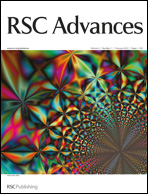Ultrasound assisted synthesis of a polyaniline hollow microsphere/Ag core/shell structure for sensing and catalytic applications†
Abstract
Polyaniline hollow microspheres (PHM) have been synthesized by the ultrasound assisted emulsion polymerization technique using polystyrene microspheres as a template, followed by the formation of a polyaniline/Ag hollow microspheres (PHMAg) core/shell structure that was characterized by X-ray diffraction (XRD), Fourier transformation infrared spectra (FTIR) and scanning electron microscopy (SEM), transmittance electron microscopy (TEM). FTIR and SEM studies of the product confirmed the complete removal of the polystyrene. The presence of silver and its distribution on the polyaniline surface was confirmed by XRD and FESEM/TEM, respectively. The electrical conductivity of the PHMAg is found to be 4 times higher than the PHM. Finally, PHMAg has successfully been used as a sensor in the detection of pyrogallol oxidation and also as an effective catalyst in the reduction of 4-nitrophenol (4-Np) under ambient conditions.


 Please wait while we load your content...
Please wait while we load your content...